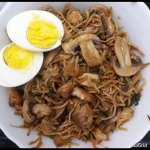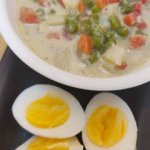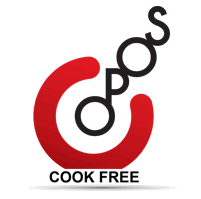Techniques – #Q for Queued Cooking


In traditional cooking, different ingredients get added in stages. Hard to cook ingredients are added first and quick cooking ingredients go in last. Else, they are cooked separately and then added together.
We needed to find a way to avoid these multiple steps. The cut size variation technique was first proposed, which solved this problem to a certain extent. In this technique, hard to cook ingredients were cut thin and easily cooked ingredients were cut thicker. This evens out their cooking times and helped OPOS curries like Aviyal/ Shukto/ Undhiyu.
However, this technique cannot be used in two cases:
1. When the cut size cannot be varied. For example, the cut sizes of green peas, sprouts or vegetables like capsicum cannot be varied much.
2. when the ingredients have very different cooking times. For example, in some curries we needed to cook mutton and egg together. In such cases, the cut size variation cannot help. Mutton cooks in around 10 whistles. Egg cooks in just one whistle. How do we match their cooking times?
Queued cooking was proposed as a solution. This is an extension of the pot in pot cooking technique. The pot in pot technique allows us to create two heating zones inside the same cooker. The queued cooking technique allows us to have as many cooking zones as we want inside the same vessel.
The outermost vessel, which is the body of the pot, experiences the highest rate of heat transfer. Each nested vessel experiences lesser and lesser heat transfer. This is the principle which makes this technique work.
By adding tough to cook ingredients in the outer vessel and easy to cook stuff in the inner vessels, we can match the cooking times of almost all foodstuffs. This ensures none of the ingredients are overcooked or undercooked.
By varying the following parameters, it is possible to precisely match the cooking times.
Controlling heat transfer:
1. Vary Buffer
The buffer used in each pot determines the rate of heat transfer. By varying the buffer and its quantity, we can match the cooking times.
a. No water cooking in outer pots and use of water in inner pots.
b. No water cooking in all pots
c. Cooking with water/ oil in all pots and
d. Cooking with water/ oil in some pots and no water/oil in other pots.
Each of the above steps would vary the rate of heat transferred and can help you to cook almost anything together, at one shot.
2. Vary contact area
The placement of the inner pots can be varied. If the inner pot rests on the floor of the pot outside it (100% contact area), the heat transfer is higher. If the inner pot instead rests on the ingredients in the outer pot (0% contact area), the heat transfer is lower.
3. Vary cut size
The ingredients in inner pots can be cut smaller to avoid undercooking. They need to be cut bigger to avoid overcooking. By covering the inner pot with a lid or foil, the heat transfer rate can be lowered.
This means rajma, potato and cauliflower can be cooked together. Tough meats and delicate seafood can be cooked together. Different starches like rice, pasta, potato and millets can be cooked together. Rice and vegetables can be cooked together. The exact timings of various combinations can be easily found by trial and error and tabulated, so that they serve as a reference.
Thus, with the queued cooking technique, we can queue up any number of ingredients so that they cook one by one and finish cooking together.
Queued cooking in action:
Cooking mutton, chicken and egg together, at one shot.
The setup: Nest ingredients as below in a 2L pot.
Outer vessel: Add 2Tbsp oil, 250g mutton chopped small, 1/2tsp each (garam masala, salt, chilli powder, GG paste).
First nested vessel placed over mutton: Mix 250g chopped chicken with 1/2tsp each (garam masala, salt, chilli powder, GG paste).
Second nested vessel placed over chicken: Add 1/4C water, 2 eggs.
Cook on high for 10 minutes (12 whistles). Let pressure settle.
